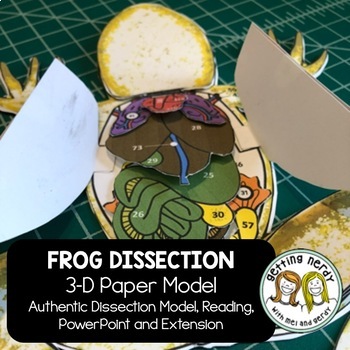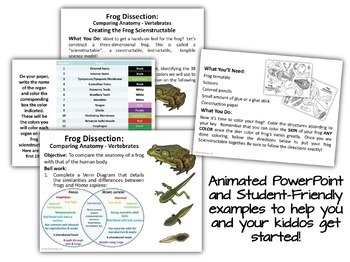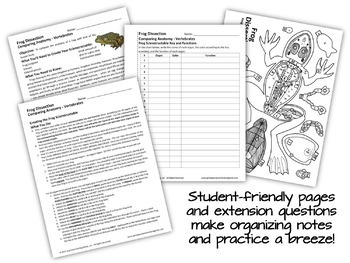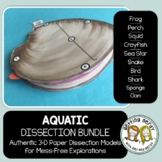Frog Dissection Lesson & Model - 3D Paper Scienstructable
- Zip
- Google Apps™

What educators are saying
Also included in
- Want to explore without the mess? Our student-friendly, budget-friendly eco-friendly 3-D Scienstructable dissection models can be used as a dissection-free exploration, a pre-dissection tool, or as a summative assessment for comparative anatomy. Explore a specimen today!SPECIMEN INCLUDED in this BUNPrice $147.96Original Price $208.60Save $60.64
- Want to explore without the mess? Our student-friendly, budget-friendly eco-friendly 3-D Scienstructable dissection models can be used as a dissection-free exploration, a pre-dissection tool, or as a summative assessment for comparative anatomy. Explore a specimen today!SPECIMEN INCLUDED in this BUNPrice $148.76Original Price $208.50Save $59.74
- Want to explore without the mess? Our student-friendly, budget-friendly eco-friendly 3-D Scienstructable dissection models can be used as a dissection-free exploration, a pre-dissection tool, or as a summative assessment for comparative anatomy. Explore one of our 15 invertebrate or vertebrate animaPrice $211.96Original Price $330.25Save $118.29
Description
Ready to make your dissection lessons less messy, less chaotic and stress-free? Our hands-on, authentic, and eco-friendly 3-D paper frog dissection model lessons are the perfect way for your students to dissect and explore frog anatomy in a way that's humane, budget-friendly and easy on the planet.
Each paper frog dissection model lesson includes a student-friendly reading that covers in-depth organism anatomy structure and function, a black-line and a color dissection specimen template provides differentiation for students who may need additional support or a little extra challenge, and a guided PowerPoint presentation that takes students through the process of how to color, cut out and assemble their true-to-life frog dissection model that they can dissect over and over again.
Created to mimic a true dissection, our 3D Scienstructable paper frog dissection models can be used as a dissection-free exploration, a pre-dissection preparation tool, or as a summative assessment for your comparative anatomy lesson in the classroom or at home. We always loved using these prior to dissection days so our students knew exactly where to make incisions and what they were looking at once their exploration began. Students who opt-out of dissection love our models for the authentic experience they get!
Our frog models and other dissection models offer templates for both sexes (where applicable). All Getting Nerdy Scienstructable paper dissection models use the same colors for organs included in the internal anatomy, so students can see the anatomical relationships among organisms, creating a true comparative anatomy experience.
WHAT'S INCLUDED in this 3-5 DAY FROG DISSECTION LESSON:
• EDITABLE PowerPoint slides with bellwork, instructions, notes and embedded answer key to handouts
• NON-EDITABLE PDF handouts
→ Student-friendly guided reading PDF
→ Differentiated graphic organizers PDF
→ Frog Dissection Template in BLACK LINE AND COLOR
→ Extension questions
→ Answer keys
• DIGITAL GOOGLE CLASSROOM LINKS can easily be converted to MS School with directions provided or altered to fit your school’s LMS
STUDENTS WILL:
• Learn about the structures of the internal and external anatomy of the frog body using the guided reading, color key and graphic organizer
• Color, cut out and assemble a 3-D Scienstructable paper frog dissection model
• Complete extension questions
TEACHERS LOVE THIS, HERE'S WHY:
❤️ Jennifer S says, "Awesome and Incredible! One of my favorite downloads from TPT! This and the worm dissection are just so wonderful! My daughter and I both loved the ease and creativity of this packet! It made for a wonderful follow up to her home school curriculum and an excellent work sample to share with her contact teacher at the quarter."
❤️ Deborah A. says, "This was a great purchase and worth the cost. Very easy to prep. Used with 7th and 8th graders before our actual dissection. Was a great learning tool for them, coloring, cutting, and assembling the paper model allowed them to get familiar with the organs and structures they would be seeing during the dissection lab. Will definitely use again."
❤️ Carolyn S. says, "Listening to students discuss the function of the different organs was incredible!"
THIS PRODUCT IS ALSO FOUND IN OUR:
• Dissection - Vertebrate Animals
• Dissection - Aquatic Animals *GROWING* Bundle
CHECK OUT OUR OTHER DISSECTION MODELS:
• Cat Dissection - 3-D Paper Model
• Crayfish Dissection - 3-D Paper Model
• Dissection - Invertebrate Animals
• Eye Dissection - 3-d Paper Model
SEE HOW THIS LESSON ALIGNS WITH NGSS, TEKS or GSE
Because we have created many of our own graphics or have purchased licenses to other graphics with permission, we cannot offer our resources in editable format unless otherwise stated.
TERMS OF USE (TOU):All rights reserved by GETTING NERDY®️.
• This product is to be used by the original purchaser only
• Intended for classroom and personal use only
• Copying for more than one teacher, classroom, department, school, or school system is prohibited.
• This product may not be distributed or displayed digitally for public view
Failure to comply is a copyright infringement and a violation of the Digital Millennium Copyright Act (DMCA). Clipart and elements found in this PDF are copyrighted and cannot be extracted and used outside of this file without permission or license.
FROG SCIENSTRUCTABLE 3D DISSECTION MODEL © 2012 to present GETTING NERDY®️ All Rights Reserved
www.gettingnerdyscience.com








